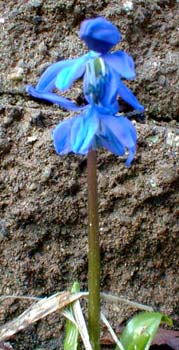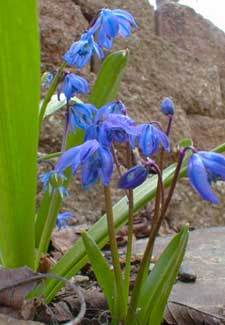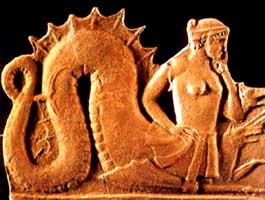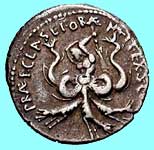
Siberian Squill
& the Myth of Scylla
"What loathsome monster of the earth
Were fit comparison? The double snake -
Or Scylla, where she dwells, the seaman's bane,
Girt round about with rocks? some hag of hell,
Raving a truceless curse."
- Aeschylus
525-456 B.C.
525-456 B.C.
 To get Siberian squill (Scilla siberica) started in our yard, twenty-five bulbs were planted in the narrow slot between a stone wall & the flagstone patio. The bulbs had blue onion-skin so they looked quite distinct from the white or brown bulbs of other species of squill.
To get Siberian squill (Scilla siberica) started in our yard, twenty-five bulbs were planted in the narrow slot between a stone wall & the flagstone patio. The bulbs had blue onion-skin so they looked quite distinct from the white or brown bulbs of other species of squill.This squill is very distinctive in form & color. In comparison to most squills of the Scilla & Hyacinthoides genera, Siberian squill is a dwarf, with grass about four inches high or less, & flower stalks three to six inches. The flowers are fewer per stem but of a Prussian blue richer & deeper than other squills. Even the anthers are intensely blue. For so tiny a thing, they definitely make an impression.
In our garden it is beginning to flower before February's end, & going gung-ho just as March begins. The blooms nod a bit but not as much as English Bluebells, so that they don't have that classic bluebell look. The half-nodding blooms are more open, with three to five petals per bloom.
It does fine in partial shade but needs a bit more light than do the English bluebells, & Siberian squill is not quite as drought hardy, requiring moist well-draining soil through the growing season.
Gardened in Europe since at least 1796, Siberian squill naturalizes with great ease & will flower late winter & early spring forever. It has escaped cultivation to naturalize in areas around the Great Lakes, in New England, & in Utah. Its best zone range is 4 through 8, though at a stretch it can go zones 2 through 9.
It is startlingly cold-hardy as Siberia really is within its extensive range, which encompasses all of Central Russia to Central Asia. It can be grown in warmer climates only if dug up each autumn to be refrigerated for a while, then put back in the garden.
The genus Scilla is named after an Etruscan All-mother, Goddess of Earth, Sky, & Ocean, named Scilla or Skylla. She was depicted on Etruscan urns as a winged maiden with serpent-like legs, rather resembling the mideastern goddess Atargatis, who was more or less a type of Ishtar, goddess of fertility & war, life & death. She also resembled the original company logo of Starbuck's Coffee.
 Her cult rivaled that of the Olympians of Greece & Rome, so that cultic tales were told by worshippers of the Olympians that portrayed Scylla in ways that demonized her or otherwise showed her defeated by & subsidiary to the Olympians. She was transformed from beautiful river-nymph into a frightful sea-monster, though even then the artists recalled something of her finer nature, as in the relief portrait shown on this page, depicting her as a pensive maiden with a serpent body.
Her cult rivaled that of the Olympians of Greece & Rome, so that cultic tales were told by worshippers of the Olympians that portrayed Scylla in ways that demonized her or otherwise showed her defeated by & subsidiary to the Olympians. She was transformed from beautiful river-nymph into a frightful sea-monster, though even then the artists recalled something of her finer nature, as in the relief portrait shown on this page, depicting her as a pensive maiden with a serpent body.Many ancient authorities describe her monstrous form as a giant maiden in torso, a serpent for her lower body, & having six snarling dog-heads issuing from her midrift, including their twelve forelimbs. This is the form of Skylla described by Hyginus, Apollodorus & Suida, among so many others, & it is this form most often depicted on vase paintings.
 At her most hideous she had few remaining maidenly qualities, but was more like a Kraken fused to a pack of hounds, as on the Pompei coin shown on this page. The coin shows her gripping in one of her tentacles a ship's rudder for a weapon, with which she beat sailors to death. This image, with the numerous bowing heads, may have contributed to her name being applied to a flower with nodding flowers on each stem. When potrayed as a beautiful maiden from the waste up, she is usually armed either with a sword with which she was capable of hand-to-hand combat with great warriors, including Heracles, or with the trident of Poseidon.
At her most hideous she had few remaining maidenly qualities, but was more like a Kraken fused to a pack of hounds, as on the Pompei coin shown on this page. The coin shows her gripping in one of her tentacles a ship's rudder for a weapon, with which she beat sailors to death. This image, with the numerous bowing heads, may have contributed to her name being applied to a flower with nodding flowers on each stem. When potrayed as a beautiful maiden from the waste up, she is usually armed either with a sword with which she was capable of hand-to-hand combat with great warriors, including Heracles, or with the trident of Poseidon.Her cult was at one time sufficiently widespread that quite different myths about her arose in sundry places. Some said Scylla was the daughter of King Nesus of Megara, who betrayed her father to the rival King Minos. Despite her assistance she failed to win Minos's love, so horrified was he by her act of patricide. Therefore she, in grief, threw herself from the cliffs into the sea, though others said she was transformed into the sacred rockdove that dwelt in the cliffs.
 Some said she was the daughter of Hekate & Triton. Others that Scylla was the daughter of Derketo, the huntress goddess of Minoan Crete. Hesiod made her the daughter of Keto, a great she-dragon called also Krataeis & related to the SumeroAkkadian dragon-mother Tiamat. This identification would make Scylla the granddaughter of Gaia & Pontos. Her father was Phorkides (Phorkys) & her sisters included the Graiai, the Gorgons, Ladon the Hesperian dragon who guarded the Golden Apples of the Sun, & the similarly fierce serpent-goddess Echidna.
Some said she was the daughter of Hekate & Triton. Others that Scylla was the daughter of Derketo, the huntress goddess of Minoan Crete. Hesiod made her the daughter of Keto, a great she-dragon called also Krataeis & related to the SumeroAkkadian dragon-mother Tiamat. This identification would make Scylla the granddaughter of Gaia & Pontos. Her father was Phorkides (Phorkys) & her sisters included the Graiai, the Gorgons, Ladon the Hesperian dragon who guarded the Golden Apples of the Sun, & the similarly fierce serpent-goddess Echidna.Apollonius of Rhodes alleged her to be the daughter of Lamia hence granddaughter of Poseidon, a princess of the great court of the sea. But in other versions, Poseidon was said to have taken the beautiful dracaina or she-dragon to his bed, then rewarded her by transforming her from dracaina into the cliffs that forever after bore her name in the Straits of Messina. Yet another variant has it that when the beautiful river-nymph became Poseidon's paramour, Amphritrite was so jealous of her husband's dalliance that it was she who transformed Scilla into a monster, who dwelt thereafter deep in a cavern of the cliffs baring her name, guardian of one of the entryways to Hades.
She had originally been Aphrodite-like in her authorities, & elements of the fertility goddess never entirely left even the monstrous form of Scylla. Thomas Lodge's erotic horror narrative of Glaucus & Scilla; or, Scillaes Metamorphosis is one of the great fantasy poems of the Elizabethan era, giving English twists to Ovid's original. Lodge writes of the sea-god Glaucus, who fell into a deep misery for love of the cold-hearted Scilla. Glaucus's mother Thetis prayed to Venus to erase her son's memory of Scilla. Venus then punished Scilla for her cruelty by causing her at last to fall for Glaucus, who no longer remembered her. Her own grief caused her to be transformed into the stony sea-side image of a monster.
In Ovid's original it is the witchcraft goddess Circe whom Glaucus implores to cause Scilla to love him. Because Circe herself loves Glaucus, she responds to his entreaty by transforming Scilla into the monster.
Ovid like Lodge was a literary author, but the mythic underpinning remains one of rival cults, such tales being told to upraise one divinity or group of divinities at the expense of another cult. Thus Scilla as rival Sea-goddess is punished for challenging the authority of Poseidon, or for rejecting Neptune's son. She is punished in much the same way as prophets of the Bible depict the god Adonai bringing the goddess Ninua (Ninevah) to a position of rape & ruin. Given the connecting thread between Scilla, Atargatis, Ishtar, & Ninua, the biblical take on this ancient Goddess can be illuminating in understanding the myths of Scilla.
God desired Ninua & would like to lie "within her" [Zepheniah 3:5]. Her presumed sin was not in her existence or her receiving worshippers, but as with Scylla who rejected Glaucus, Ninua's sin was in her refusal to accept Adonai as her consort, for "She listens to no voice, she accepts no censure, she does not trust in the Lord, she does not draw near to her God" [3:2]. She rejected God as her suitor, & in her own voice Ninua said, "I am & there is none beside me" [2:15], "I am" being a divine epithet, and "none beside me" indicating that her consorts were inferior to her.
The prophet Nahum calls Ninuah "the well-formed harlot, mistress of witchcraft" which is also translated as, "the harlot, graceful of deadly charms" [Nah 3:4], & when God rebukes her he rebukes the sea [1:4]. Because she was warlike, her priestesses were sometimes Amazons, hence we find Nahum stating "your troops are women in your midst" [3:13], a satiric comment on the literal conditions of fierce Ishtar virgins. Like Scylla defeated by Hercules, Ninua is stripped naked & ravaged [2:7], & even Nahum seems a bit sorry when asking, "Wasted is Ninua; who will bemoan her? Whence shall I seek comforters for her?" [3:7]. "She was carried away, she went into captivity; her little ones were dashed in pieces" [3:10] is an allusion both to the slain inhabitants of Ninua's sacred city, & to the shattered idols of her cult's pantheon.
Such tales as those of Ninua or Scylla have an underlying admission of the success of the rival, who would not otherwise need so greatly to be undermined in religious tales. Thus in scripture Adonai rapes & humiliates Ninua after she refuses to be his bride, just as in Greek & Roman myth, the sea's royal family of Neptune, Thetis, & Glaucus is given vengeance against Scylla who will not be the bride of Prince Glaucus.